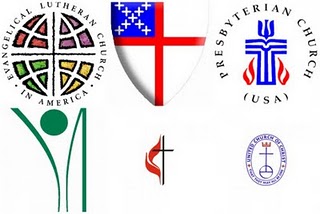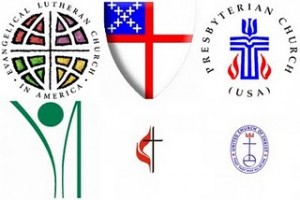Ecumenism in a Post-Denominational Time – Neal D. Presa
The inductive method.
In grade school and high school, we were taught the deductive method of writing:
- Develop a thesis statement
- Develop three sets of arguments that support the thesis: roman numeral I, II, III
- Underneath each roman numeral (supporting statement), were three sub-points that supported the argument, labeled lowercase a, b, c.
- Based on this outline, you were ready to write a paper, argue your point, and
based on the evidence that you obtained to support the thesis, you round out the argument with a grand conclusion.
For purposes of this conversation, let’s engage in the inductive method, shall we? Rather than coming up with some grand thesis statement, let me present three pieces of what may appear at first glance to be disparate elements, but true to the inductive method, may point towards contours of “Ecumenism in a Post-Denominational Time.”
First Piece: Ecumenical Stance Statement of the Presbyterian Church (U.S.A.)
In 2008, the 218th General Assembly of the Presbyterian Church (U.S.A.) approved an “Ecumenical Stance Statement” that described ecumenical achievements, exegeted present challenges and opportunities in the ecumenical landscape, and proposed pathways for ecumenical engagement for at least the next ten years. The Ecumenical Stance Statement underlined ten priority commitments emerging from “contours of new ecumenical realities:”
- Growing the Ecumenical Vision
- Facing Obstacles to Christian Unity
- Bridging the Gaps Between the Local and the Global, Individual Congregations
- and the Denomination
- Enlarging the Table of Ecumenical Relationships
- Covenanting for Justice in the Economy and the Earth
- Covenanting for Peacemaking in a War-Torn World
- Nurturing Interreligious Engagements
- Renewing a Commitment to Disciplines of Christian Spirituality
- Celebrating Gifts We Receive and Share
- Revitalizing Practices of Ecumenical Formation
The Stance Statement codified what had been the practice of Presbyterian ecumenical engagements for many years, but advanced it towards its logical consequence. Presbyterian ecumenical and mission partnerships have historic commitments to seeking visible unity in the body of Christ; advocating for and standing in solidarity with the marginalized; promoting the integrity of justice, peace and creation; and being committed to the formation, conscientization, and education of present-future generations of ecumenists.
The Stance Statement went further than previous statements in orienting the Presbyterian Church in its understanding of “ecumenism” (Gr. oikumene) to denote not merely unity among Christian communions, nor primarily achieved via conciliar bodies; in underlining the fact that oikumene designates the entirety of the household of God, ecumenical efforts cannot and should not be restricted to unity in the Church, but must encompass reconciliation in its widest and broadest sense, namely all of creation and all that is in them.
Second piece: Peter Block on Community Conversations
A group of 100 or so pastors and several denominational executives gathered in Philadelphia last week for a leadership gathering to learn from Peter Block, a world renowned organizational consultant who has provided assistance to such organizations as the World Bank and the government of Dubai. Block is Jewish and admitted that this pastoral leadership forum was the first event he had ever been invited to involving Christian clergy. Block taught us a “methodology of collaboration and conversation,” principles of which are described in detail in his Community: The Structure of Belonging (San Francisco: Berrett-Koehler Publishers, Inc., 2008). He drew a distinction between a world far too accustomed with straight lines and comfortable with triangles epitomized in Pharaoh of the Exodus narrative – a patriarchy (hierarchy with force) that promised goods and services, that preyed on gaps and deficiencies; that world in contradistinction to a world of circles, community, where relationship is the ends, not the means, where conversations are what matter, where dissent does not diminish one’s sense of belonging, where collective ownership happens, and where the communities speak of possibilities, potentials (and yes, prayers), not 5-year goals. Block noted:
We change the culture by changing the nature of the conversation. This is more than
improving the conversation or becoming more skilled at dialogue. It is about choosing
conversations that have the power to create a new future.
He speaks about the characteristics of such conversations:
This (transformation) occurs when we shift the conversations from problem solving
to possibility, deficiencies and needs to gifts, lip service to dissent, blame to ownership,
and barter to commitment.
Third piece: Why the Church?
I had the privilege of serving on a 5-member delegation from the then- World Alliance of Reformed Churches (WARC) to a “Harvesting the Fruits” symposium hosted by the Pontifical Council for Promoting Christian Unity (PCPCU) in Rome this past February. We joined delegations from the Anglican Communion, the World Methodist Council, and the Lutheran World Federation as the PCPCU desired to assess the “fruits” of four decades of bilateral dialogues with these four Protestant communions, the initial ecumenical interlocutors with the Roman Catholic Church consequent to the Second Vatican Council (1962-65), particularly the Decree on Ecumenism (Unitatis Redintegratio).
While we affirmed several basic agreement on Trinitarian theology, Christology, sacramentalogy, and ecclesiology, there were still wide divergences in these same areas, most especially on ecclesiology.
A question was asked, “What are the marks of the Church? Where is the Church to be found?” This question struck me as akin to the 16th century Reformers’ question of how do we know where the “true Church” is to be found?
In hearing the ensuing discussions at the symposium, I was compelled to pose the question to colleagues, “Why the Church?”
What is it about the Church? I have argued in another place about my thoughts on this matter[1], but for our purposes, I think that question must be asked not in an abstract, Aristotelian sense of “Church” but nuanced with the query, “What is it about the Church in ______?” and fill in the blank with particular contexts – North, East, West, South.
The late ecumenical leader John Mackay called it “dynamic centrality.” Barthians call is “unity-in-distinction” in referring to the Chalcedonian formula. Ecumenists call it “unity-in-diversity.” What would it mean to ask about the nature and mission of the Church, and therefore, the nature and mission of ecumenism in particular contexts, local expressions?
These three disparate elements – the Ecumenical Stance Statement of the Presbyterian Church (U.S.A.), Peter Block on community conversations, and “Why the Church?” – they point to 21st century potentials for vibrant, creative ecumenical engagements. It is hard to forecast with a crystal ball what the next 90 years will be like, but we can point to certain things which these three elements direct our footsteps on the way:
- Broad and Wide Partners: Ecumenism in a post-denominational time engages not just those within the Christian household, or even the faith households, but every sector of our societies. In August, I was in Geneva and commented to a leader of the World Council of Churches that foundations like the Clinton Global Initiative and the Bill and Melinda Gates Foundation impact education, relief, and poverty work in the United States and around the world in ways that conciliar bodies are unable to, and which have access to governments and their leaders far beyond what conciliar statements do to influence stakeholders.
- Conversations Matter: Ecumenism in a post-denominational time seeks broad conversation partners for the conversation and asks the right questions. In his 2010 Abraham Kuyper Prize lecture at Princeton Theological Seminary, Chief Rabbi Lord Jonathan Sacks distinguished between contract-based (ancient Greece) and covenant-based societies (Israel).[2] He argued forcefully, as he did in The Dignity of Difference that we in the faith community have much to offer the world communities as we bring to the conversation notions of covenant, ethical responsibility and accountability, history, and tradition. What ecumenism brings to the tables of dialogue is a sense that we become community through conversations, that what matters are the questions, not so much as the answers.
- Why The Church In ______?: Ecumenism in a post-denominational time seeks to account for particular, local ecclesiologies, concrete instances of how people of faith understand “Church” in their contexts and circumstances. This is not to say that conciliar statements and bodies are not needed; they are needed and will always have a place in the communal conversations. Conciliar bodies provide the historical and spatial tethering to what has gone before us, and a visible reminder that our local, regional expressions and understandings are connected to wider bodies, to many other communions…conciliar bodies inoculate us against the centripetal proclivity that somehow my context is the only thing that matters. Rather, it’s a both/and, a tethering flexibility, of accounting for particular communities and theologies, while keeping in mind the broader and wider global communities to which we belong.
Broad Partners. Community conversations. Particular contexts in tethered flexibility.
Ecumenism in a post-denominational time is about the inductive method.
[1] Neal D. Presa, “Take, Bless, Break, Give: Reflections from a Reformed Perspective on ‘Why the Church?’” Ecumenical Review , October 2010 , 62:3, pp. 282-288.
[2] See also Jonathan Sacks, The Dignity of Difference: How to Avoid the Clash of Civilizations (New York: Continuum, 2003)



Thanks so much, Neal. I am deep in work on a book project on healing ministries in Madagascar, and have thought a lot about “what is it about the church” there. The churches are filled there, in part, I believe, because of a sense that in a very poor country rocked by political crisis, disciples see Jesus as the only reliable source of power and strength. What is it about the church there? The sheer vibrancy and perseverance of faith certainly is one thing that makes the church in Madagascar striking.
I am interested in what you are seeing in your travels now and what impressions you will bring back on the questions you pose.
Thanks much — Cynthia